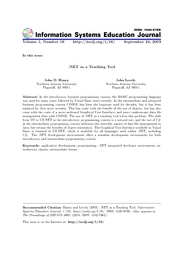Volume 1
Volume 1, Number 16 |
September 24, 2003 |

|
John D. Haney
John Lovely
|
Abstract: In the introductory business programming courses, the BASIC programming language was used for many years followed by Visual Basic more recently. In the intermediate and advanced business programming courses COBOL has been the language used for decades, but it has been replaced by Java more recently. This has come with the benefit of the use of objects, but has also come with the costs of a more awkward Graphical User Interface, and more cumbersome data file management than with COBOL. The use of .NET as a teaching tool solves this problem. The shift from VB to VB.NET in the introductory programming courses is a natural one, and the use of C# in the intermediate programming courses addresses the unwieldy nature of data file management in Java, but retains the benefits of object-orientation. The Graphical User Interface available in Visual Basic is retained in VB.NET, which is available for all languages used within .NET, including C#. The .NET development environment offers a seamless development environment for both introductory and intermediate programming courses.
Keywords: application development, programming, .NET integrated developer environment, introductory classes, intermediate classes
Download this issue: ISEDJ.1(16).Haney.pdf (Adobe PDF, 8 pages, 416 K bytes)
Preview the contents: Haney.txt (ASCII txt, 15 K bytes)
Recommended Citation: Haney and Lovely (2003). .NET as a Teaching Tool. Information Systems Education Journal, 1 (16). http://isedj.org/1/16/. ISSN: 1545-679X. (A preliminary version appears in The Proceedings of ISECON 2003: §3214. ISSN: 1542-7382.)